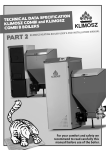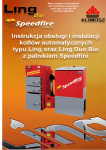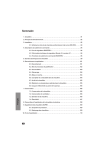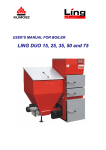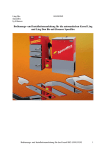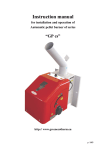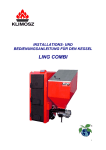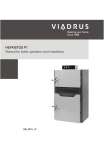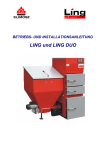Download Operation and installation manual. 2014.11.12 1
Transcript
1 Operation and installation manual. 2014.11.12 1. Technical Data for KLIMOSZ MULTIDUO Table 1. Dimensions and technical parameters of the KLIMOSZ MULTIDUO boiler. kW % kW Klimosz MultiDuo 15 17 / 17 85,1 5,1 ÷ 17 Klimosz MultiDuo 20 20 / 18,5 89,3 5,5 ÷ 18,5 Klimosz MultiDuo 32 32 / 30 87,3 9,6 ÷ 30 kg/h 2,5 2,9 4,8 kg/h kg/h dm3 3,0 3,8 230 3,2 4,1 230 5,4 6,9 230 day 8,0 7,0 4,5 day day 7,0 5,5 6,5 5,0 4,0 4,5 g/s 11 14 18 °C kg kg m2 dm3 mm Pa bar bar bar - 100 ÷ 170 3/3 425 435 2,1 70 160 10 ÷ 20 100 ÷ 170 3/3 510 525 3,1 92 160 10 ÷ 20 100 ÷ 170 3/3 540 560 3,5 105 160 15 ÷ 20 1,5 (version B 2,5) 2,2 (version B 3,7) 2 - wather 65 ÷ 80 Parametr SI Nominal power Efficiency Power regulation scope Use of fuel at nominal power – continuous heating - pea coal - brown coal - pellets 18 MJ/kg Storage bin volume Approximate combustion time at nominal power - pea coal - brown coal - pellets Flow of fumes in the smoke conduit - brown coal - nominal power Fumes’ temperature Boiler class Mass Mass version B1 2,5 Heating area of the boiler Water volume Diameter of fumes outlet Chimney draught Water maximal working pressure Water minimal working pressure Water maximal trial pressure Fluid group Recommended working temperature for heating water Maximal working temperature for heating water Minimal temperature of water returning to the boiler Maximal permitted level of heating material Safety valve Noise level Connections of the boiler - heating and returning water Resistance of water flow through the boiler ∆t = 20oC Voltage Electric energy consumption (fan / motor) Electric energy consumption (shot light-option) Electric insulation °C °C 90 50 °C m bar dB 15 (version B 25) 1,5 (version B 2,5) < 65 (A) 1½” mbar W W 20 ÷ 30 230V / 50 Hz 180 / 80 400 IP 40 Operation and installation manual. 2014.11.12 2 2. Technical Data for KLIMOSZ MULTICOMBI Table 2. Dimensions and technical parameters of the KLIMOSZ MULTICOMBI boiler. Klimosz MultiCombi 32 30 / 25 84,7 9,6 ÷ 32 kg/h 3,1 4,9 kg/h 3,7 5,6 dm3 230 230 day 7,0 4,0 day 5,5 4,0 g/s 11,7 17 °C kg m2 dm3 mm Pa bar bar bar - 100 ÷ 210 4 490 40 156 10 ÷ 20 100 ÷ 220 3 520 50 156 15 ÷ 20 SI Nominal power Efficiency Power regulation scope Use of fuel at nominal power – continuous heating - pea coal - brown coal Storage bin volume Approximate combustion time at nominal power - pea coal - brown coal Flow of fumes in the smoke conduit - brown coal - nominal power Fumes’ temperature Boiler class Mass Heating area of the boiler Water volume Diameter of fumes outlet Chimney draught Water maximal working pressure Water minimal working pressure Water maximal trial pressure Fluid group Recommended working temperature for heating water Maximal working temperature for heating water Minimal temperature of water returning to the boiler Maximal permitted level of heating material Safety valve Noise level Connections of the boiler - heating and returning water Resistance of water flow through the boiler ∆t = 20oC Voltage Electric energy consumption (fan / motor) Electric energy consumption (shot light-option) Electric insulation 3 kW % kW Klimosz MultiCombi 20 20 / 16 84,5 6,0 ÷ 20 Parametr 4,0 5,9 2 - woda 65 ÷ 80 °C °C 90 50 °C m bar dB 30 4,0 < 65 (A) 2” lub 6/4” GZ mbar 0,4 ÷ 20 W W 230V / 50 Hz 180 / 80 400 IP 40 Operation and installation manual. 2014.11.12 3. Construction of a KLIMOSZ MULTIDUO boiler The KLIMOSZ MULTIDUO automatic boiler is not maintenance-free and requires the user to carry out some periodic maintenance activities; it is therefore recommended that the user should carefully read the principles of its operation, regulation and maintenance in order to avoid any problems related to its working. The main part of the boiler is a steel heat exchanger, made from 6-8 mm thick internal sheet. In the bottom part of the exchanger there is a combustion chamber with a chute (horizontal) burner and fire-resistant catalyst. The fire-resistant catalyst stabilises the burning process, reduces emission of particulates from ash and radiates heat back to the burner, thereby facilitating the complete burning of the fuel. Under the combustion chamber there is an ash pan. The boiler door is constructed in a way that allows to open it from left to right (hinges on the left of the exchanger, the handle on the right). KLIMOSZ MULTIDUO boilers can be also installed in a closed system up to working pressure 1,5 bar (standard version) or on special order in the B construction up to pressure 2,5 bar. Next to the boiler, there is a fuel storage bin with a feeder screw at the bottom. The ash pan capacity is suited to the capacity of the fuel bin, i.e. the ash pan should be filled with ash after fuel from the bin – pea grade coal – has been burnt. There is a water tank behind the fuel bin for extinguishing the fuel bin in an emergency (when the boiler is fired with pea grade coal) or the connector for mounting a thermostatic valve (required when the boiler is fired with biomass). The connector is installed only when a boiler for pellets is ordered. The water tank of the emergency extinguisher opens onto the feeder screw. The fan which provides air for combustion is situated before the fuel bin and is connected with a burner. The amount of air for combustion can be regulated by changing the fan rotation speed on the boiler regulator (recommended) or by manual setting of the choking flap on the fan. The heating water inlet is situated on the back wall of the exchanger, in its bottom middle; the water outlet is situated on the top left and right. In the back of the boiler there is a smoke conduit, which carries flue gas to the chimney. The steel exchanger, its cover as well as lower and upper door, are covered with mineral insulation, which reduces heat loss during combustion. The steel casing is protected with high quality powder paint. 4. Construction of the KLIMOSZ MULTICOMBI boiler The KLIMOSZ MULTICOMBI automatic boiler is not maintenance-free; it is therefore recommended that the user should carefully read the principles of its operation, regulation and maintenance in order to avoid any problems related to its work. Construction of the KLIMOSZ MULTICOMBI boiler makes it possible to use solid fuels in the automatic or traditional mode. The boiler has been constructed on the base of a cast-iron exchanger of the multi-purpose VIADRUS U22 boiler. The cast-iron part of the boiler, which is called the upper combustion chamber, can be used for burning coal, coke or wood as substitute fuel after manual fuel loading. KLIMOSZ MULTICOMBI boilers can be installed also in a closed system up to working pressure 4,0 bar. Under the water grate of the boiler heat exchanger of a U22 boiler, there is an added steel combustion chamber, with (W version) or without (S version) a water jacket. There are the chute (horizontal) burner in the lower combustion chamber. Fuel burning (pea grade coal, pellets) in automatic mode takes place in the lower chamber. Under the combustion chamber there is an ash pan. Next to the boiler, there is a fuel storage bin with a feeder screw at the bottom. The ash pan capacity is suited to the capacity of the fuel bin, i.e. the ash pan should be filled with ash after the entire fuel from the bin has been burnt. There is a water tank behind the fuel bin for emergency extinguishing (when pea grade coal is used as fuel) or a place for installing a thermostatic valve (required when pellets are used as fuel) – a protective device in case flame gets to the fuel bin. Operation and installation manual. 2014.11.12 4 The fan which supplies air for combustion is situated before the fuel bin and is connected to the mixer. The amount of air is controlled electronically by the boiler regulator. The inlet and outlet of heating water is situated at the back part of the boiler. At the back of the boiler there is a smoke conduit, which carries flue gas to the chimney. The exchanger is insulated with mineral wool, which reduces heat loss during combustion. The steel casing is protected with high quality powder paint. Fig. 1. Dimensions boilers KLIMOSZ MULTIDUO. S L H S1 S2 L1 L2 L3 H1 H2 Z1 Z2 P1 P2 U1 U2 [mm] [mm] [mm] [mm] [mm] [mm] [mm] [mm] [mm] [mm] [mm] [mm] [mm] [mm] [mm] [mm] 15 1200 750 1385 550 600 630 125 590 1100 1300 178 90 70 275 55 105 20 1200 825 1555 550 600 725 100 710 1285 1300 178 90 70 275 55 105 32 1270 825 1555 620 600 725 100 710 1285 1300 178 90 70 275 55 105 5 Operation and installation manual. 2014.11.12 The dimensions of the flue height are given below: Klimosz Duo 15 - 1260 mm Klimosz Duo 55 ÷ 75 - 1760 mm Klimosz Duo 25 ÷ 45 - 1420 mm Klimosz Duo 100 ÷ 150 - 1920 mm Fig. 2. Dimensions boilers KLIMOSZ MULTICOMBI. S L H S1 S2 L1 L2 L3 H1 H2 Z1 Z2 P1 P2 U1 U2 [mm] [mm] [mm] [mm] [mm] [mm] [mm] [mm] [mm] [mm] [mm] [mm] [mm] [mm] [mm] [mm] 20 1180 795 1555 550 600 725 82 710 1140 1271 250 275 450 275 435 180 32 1180 900 1555 550 600 725 82 710 1140 1271 250 275 450 275 435 180 Operation and installation manual. 2014.11.12 6 A B C Combustion chamber [mm] [mm] [mm] [dm3] MULTIDUO 15 320 394 360 45,4 MULTIDUO 20 285 475 360 48,7 MULTIDUO 32 285 475 430 58,2 410 340 350 48,8 410 435 350 51,7 MULTICOMBI 20 MULTICOMBI 32 5. Hand-fired furnace of the KLIMOSZ MULTIDUO and KLIMOSZ MULTICOMBI boiler The KLIMOSZ MULTIDUO and KLIMOSZ MULTICOMBI boilers provides the possibility for burning solid fuels in the traditional mode. After manual loading, wood and coal, as substitute fuel, can be burnt in the upper part of the exchanger, called the "upper combustion chamber". The upper combustion chamber is an emergency chamber, in which burning throughout the heating season is not recommended due to the lower power capacity achieved as compared to the maximum power capacity of the boiler. For burning in the upper chamber to run properly, some conditions for chimney draught have to be met. NOTE No alterations in the furnace chamber may be made which could negatively affect the life-span of the boiler or flue gas emission. 7 Operation and installation manual. 2014.11.12 1: Air mixer, 1: Secondary air jets (pipes), 3: Primary air inlet, 4: Inspection hole, 5: Hole flap, 6: Screws Fig. 3. Schematic diagram of a chute (horizontal) burner. 6. Installation of the fire-resistant catalyst The ceramic catalyst in KLIMOSZ boilers consists of rectangular plates (Table no. 3). The plates should be put on shelves above the retort burner through the lower door of the ash pan. When pellets are used as fuel, the catalyst should be put on lower projections. ATTENTION! The boiler must not be operated without ceramic catalysts in the retort furnace, as it leads to accelerated depositing of soot on the boiler due to incomplete burning, and to quicker wearing of the boiler’s steel parts. Burning pea grade coal with the catalyst in the low position (lower shelf) may result in damaging it. Table 3. Dimensions and number of catalysts (chamotte) in a KLIMOSZ MULTIDUO, KLIMOSZ MULTICOMBI boiler. Boiler KLIMOSZ MULTIDUO Klimosz MultiDuo 15 Klimosz MultiDuo 25 Klimosz MultiDuo 35 KLIMOSZ MULTICOMBI Klimosz MultiCombi 20 Klimosz MultiCombi 32 Plate 1 [mm] 345 x 220 ceramika 345 x 220 ceramika 400 x 320 ceramika Chamotte plate 3 pc 4 pc Operation and installation manual. 2014.11.12 8 Fig. 4. Position of ceramic catalyst on the exchanger shelves in a KLIMOSZ MULTICOMBI. 7. Lighting the boiler The boiler may be operated only by adults, who know the principles of its operation, and who follow this Operation Manual. The following should be done before the boiler is lit: • check whether there is enough water in the central heating and domestic water systems; • check whether the grate, ash pan and flue conduits are clean; • remove the ceramic catalysts from the retort furnace chamber; • put the protective plate on the retort burner (this prevents lighting the fuel in the retort burner as a result of embers falling down from the upper grate to the ash pan); • when burning in the upper chamber in the hand-firing mode, remove fuel from the retort in order to properly supply air for combustion. When burning is continued for more than two weeks, fuel should also be removed from the bin; • switch on the hand-firing mode – “hand firing” in the burning type options on the regulator. Put firelighter (paper) and wood through the charging door over the entire grate area. Light the firelighter through the door of the combustion chamber. Close the door and open slightly the ash pan door, providing air supply to the combustion chamber. Put a layer of fuel onto the burning wood. After lighting the fire, switch the regulator to the hand-fire mode, set the desired temperature and close the ash pan door. When the fuel is burning well, stoke the fire by putting in another portion of fuel (switch off the blow-in fan on the regulator when loading in fuel) Attention!!! No flammable liquids can be used and the boiler cannot be overheated when lighting the fire. No flammable materials can be left near the boiler. 8. Boiler operation Fuel should be topped up as needed and in accordance with the intensity of burning. Fuel should be added evenly so that it does not form a pyramid. Ash and slag should be removed from the grate only when it starts to hinder combustion. The procedure should be interrupted when, during the grate cleaning with a hook, embers start to fall down to the ash pan. In the evening, before burning in the boiler during the night, the grate should be cleaned thoroughly. In the morning, after night burning, remove caked coal with a hook to clear the air supply. Put some fuel onto the embers and do not remove ash and caked fuel from the grate until the fuel is burning. Then add fuel until the combustion chamber is full. Each time you check the amount of fuel in the combustion chamber and each time before stoking the fire, switch off the fan on the regulator (preferably by switching off the regulator) and delay opening the loading door until the fan stops; the door is leak-tight and you should first loosen it slightly, wait until pressure in the combustion chamber equalises and only then can you open the door fully. This will prevent 9 Operation and installation manual. 2014.11.12 hot flue gas from being blown out into the boiler room. The lower door of the furnace, the door of the lower combustion chamber and the loading door must be tightly closed during the boiler operation. NOTE: When opening any of the boiler's doors, stand in such a way as to prevent any hot gas from the boiler from causing harm to you or to anyone standing nearby. Adding more fuel – switch off the fan first (preferably by switching off the regulator). After the fan is switched off and stopped, open the lower door of the boiler. Open the upper door of the boiler after a while, unsealing it first, and put in a layer of fuel. After the upper and lower door is closed, switch on the fan by pressing the button (as above). The boiler is now in normal operation mode. Do not add too much fuel as it may cause the boiler to overheat quickly and it negatively affects the boiler's parameters as well as the parameters of emission of hazardous substances in flue gas. 9. Boiler maintenance Remove ash to non-flammable, closed containers with increased resistance to corrosion (for example zinc-plated). The boiler can be cleaned only after it has been extinguished and cooled down!!! Cleaning the walls of the upper combustion chamber can be easily done through the open upper door. Cleaning the smoke conduits is done through the inspection hatch under the casing (the same as cleaning in automatic mode). The boiler can be cleaned with the cleaning tools supplied with it. A boiler that has been soiled with tarry substances should be cleaned in two steps. First, tarry deposits should be burnt out with suitable agents (for example Sadpal), and then the heat exchange areas should be cleaned with a brush. Cleaning semi-liquid tarry deposits results in damage to the brush and is ineffective, resulting only in spreading the tar over the boiler surface. After the boiler surface and smoke conduits have been cleaned, close the inspection hatch tightly. NOTE: Avoid accumulation of tarry deposits and soot on the heat exchanger areas and in smoke conduits. This reduces the boiler’s efficiency and poses a serious hazard of soot and tar ignition in the chimney duct, which usually results in damaging the chimney and even the building walls and in fire. Take care to make the boiler leak-tight (combustion chamber door, ash pan door, mixer cleaning hole, fuel bin cover, etc.) in order to avoid flue gas being expelled from the boiler into the boiler room. If the boiler is not in use for more than 2 days (for example, after the heating season), it must be cleaned and the fuel bin and the fuel feeding system emptied of fuel. Leave the boiler with the doors and inspection hatch covers open to enable its ventilation and to avoid moisture condensation on the steel surfaces of the boiler. Operation and installation manual. 2014.11.12 10










